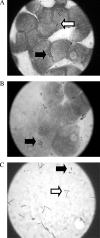Inhibition of Neisseria gonorrhoeae epithelial cell interactions by vaginal Lactobacillus species
- PMID: 18411284
- PMCID: PMC2446695
- DOI: 10.1128/IAI.00101-08
Inhibition of Neisseria gonorrhoeae epithelial cell interactions by vaginal Lactobacillus species
Erratum in
- Infect Immun. 2012 Oct;80(10):3742
Abstract
High levels of Lactobacillus, the dominant genus of the healthy human vaginal microbiota, have been epidemiologically linked to a reduced risk of infection following exposure to the sexually transmitted pathogen Neisseria gonorrhoeae. In this work, a cell culture model of gonococcal infection was adapted to examine the effects of lactobacilli on gonococcal interactions with endometrial epithelial cells in vitro. Precolonization of epithelial cells with Lactobacillus jensenii, Lactobacillus gasseri ATCC 33323, or L. gasseri ATCC 9857 reduced gonococcal adherence by nearly 50%. Lactobacilli also inhibited gonococcal invasion of epithelial cells by more than 60%, which was independent of the effect on adherence. Furthermore, lactobacilli were able to displace adherent gonococci from epithelial cells, suggesting that these organisms have potential as a postexposure prophylactic. Thus, vaginal lactobacilli have the ability to inhibit gonococci at two key steps of an infection, which might have a significant effect in determining whether the gonococcus will be able to successfully establish an infection following exposure in vivo.
Figures






References
-
- Antonio, M. A., S. E. Hawes, and S. L. Hillier. 1999. The identification of vaginal Lactobacillus species and the demographic and microbiologic characteristics of women colonized by these species. J. Infect. Dis. 1801950-1956. - PubMed
-
- Arvidson, C. G., R. Kirkpatrick, M. T. Witkamp, J. A. Larson, C. A. Schipper, L. S. Waldbeser, P. O'Gaora, M. Cooper, and M. So. 1999. Neisseria gonorrhoeae mutants altered in toxicity to human fallopian tubes and molecular characterization of the genetic locus involved. Infect. Immun. 67643-652. - PMC - PubMed
-
- Boris, S., J. E. Suarez, and C. Barbes. 1997. Characterization of the aggregation promoting factor from Lactobacillus gasseri, a vaginal isolate. J. Appl. Microbiol. 83413-420. - PubMed
Publication types
MeSH terms
Substances
Grants and funding
LinkOut - more resources
Full Text Sources
Other Literature Sources
Molecular Biology Databases

